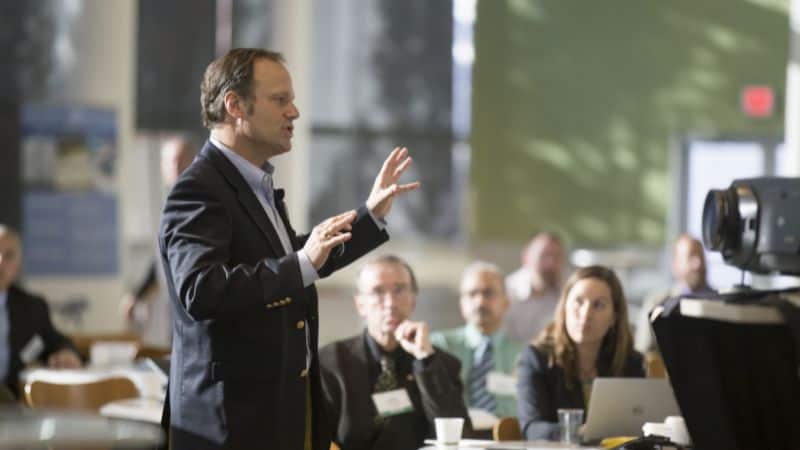Persuasive speeches are talks aimed at convincing the audience to accept a particular viewpoint or take specific action. They use clear arguments, emotional appeals, and engaging stories. For leaders, mastering persuasive speeches means they can better inspire their teams, influence decisions, and drive change.
For 20 years, I’ve been a professional speaker, and I’ve seen the same pattern repeatedly. Managers step up to deliver a presentation with one primary goal: to push their agenda. Their objective is clear—to inform, to persuade, but always from their perspective.
They overlook the audience’s needs, focusing solely on what they want to say. This agenda-driven mindset sets the stage for a disconnect.
Managers think they know best. They assume their data will speak for itself. 1
But it doesn’t.

Why Leaders Fail to Persuade
There are a few reasons why leaders fail to persuade. Naming them will help you improve your persuasive skills.
Which of these prevented you from delivering persuasive speeches?
The Fear of Inadequacy
Fear is a powerful motivator. Managers fear being seen as incompetent or unprepared. They believe that an avalanche of data will shield them from scrutiny.
They think that drowning their audience in information will prove their expertise. But this fear drives them to miss the mark entirely.
In their quest for perfection, they lose sight of the audience. They hide behind facts, hoping to avoid tough questions.
The Illusion of Authority
Long presentations are often mistaken for thoroughness and authority. Managers prepare sixty-minute speeches, convinced that more time equals more impact.
They don’t realize that fifteen minutes, well-structured and engaging, can be far more effective.
This illusion keeps them trapped in an ineffective approach. Less is more, but they don’t see it. They keep talking, hoping something will stick.
The Data Overload
Many managers believe that to persuade, they must inundate their audience with facts, data, and statistics. Their slides are packed with numbers and charts, leaving little room for anything else.
They see data as the cornerstone of their argument, the more, the better. But this approach often leads to disengagement and information overload.
The audience tunes out. They get lost in the numbers.
The message is buried under a mountain of data.
The Monologue Trap
Interaction is seen as a risk, a potential threat to their carefully planned presentation. Questions from the audience are perceived as interruptions, not opportunities. Managers stick to their script, delivering a monologue instead of engaging in a dialogue.
This rigidity stifles connection and engagement. They talk, but they don’t listen. The audience feels excluded, not included.
The Storytelling Stigma
Storytelling is viewed with suspicion, deemed unprofessional or irrelevant. Managers avoid personal anecdotes and case studies, fearing they’ll undermine their message.
They don’t see that stories can make their data come alive, creating emotional connections. This stigma prevents them from using one of the most powerful tools in persuasive speaking.
A good story can turn facts into feelings. It can make complex ideas simple. But they miss this chance.
The Company Profile Pitfall
When presenting to clients, managers often spend more than half their time on their company profile. They believe this builds credibility and sets the stage.
But clients are left wondering, “What’s in it for me?” This self-focused approach fails to address the audience’s needs and interests.
They miss the point entirely. The presentation should be about the audience, not the presenter.
The Disconnect
Presentations are meant to engage and persuade the audience. Yet, many managers, especially technical experts, miss this crucial point.
They talk at their audience, not with them, focusing on delivering information rather than creating engagement. This disconnect is at the heart of their presentation problems.
The audience needs to feel involved. They need to be part of the conversation. But managers often fail to make this happen.
The Realization
The real issue isn’t a lack of data or preparation. It’s a fundamental misunderstanding of what makes a presentation persuasive.
I remember my early days in Toastmasters, eager to share my knowledge and passion for teaching. But there was a moment that changed everything for me.
It was a lesson I learned from Vic, a seasoned speaker and mentor. One day, after a particularly dense presentation, he pulled me aside for a chat.
“Jef,” he said, “I can see how passionate you are about teaching. You want to share what you know. But you’re doing it from where you’re coming from.”
I was puzzled. Wasn’t that the point? To share my expertise?
Vic continued, “A speech isn’t about something. A speech is for someone. You need to keep that someone front and center. And that someone isn’t you. It’s your audience.“
This was a revelation. All this time, I had been focused on my content, my delivery, and my points. I had neglected the most important aspect: the audience.
The Shift in Focus
Vic’s words stayed with me. He explained that every story I told, every point I made, should be about my audience. Their needs, their challenges, their transformation.
I needed to paint their journey, their struggles, and their victories. My role was to guide them, to make the experience as immersive as possible.
Stories became my bridge to the audience. I learned to weave narratives that resonated with their experiences.
Instead of overwhelming them with data, I used anecdotes and case studies. I painted vivid pictures of what could be, drawing them into the story.
Vic also taught me the value of interaction. He encouraged me to ask questions, and to invite participation.
Instead of delivering a monologue, I started having conversations. This shift made my presentations more dynamic and engaging.
With Vic’s guidance, I transformed my approach. Each speech was crafted with the audience in mind.
I focused on their goals, their pain points, and their aspirations. My presentations became more about them and less about me.
The results were remarkable. My speeches resonated more deeply. Audiences were more engaged, and more responsive.
I was no longer just a speaker. I was a storyteller, a guide, and a partner in their journey.
The My Agenda-driven presentations were behind me. I had entered a new world, where persuasive speaking was about creating connections and inspiring action.
This new mindset changed everything. And it can do the same for you.
Great leadership isn’t an event—it’s a habit. Get actionable leadership habits every Monday and Thursday.
How to Deliver Persuasive Speeches
To transform your speeches, you must start with the audience. This means understanding their needs, concerns, and aspirations.
Begin by asking yourself: Who is my audience? What do they care about? What challenges do they face? When you answer these questions, you can tailor your message to resonate with them.
People connect with stories. A well-told story can make your message memorable and impactful.
Think of a story that illustrates your main point. Make it relatable to your audience’s experiences.
For example, if you’re addressing a team struggling with a new project, share a story about overcoming similar challenges. Show them the journey and the transformation.
A clear structure helps your audience follow along. Start with a strong opening that grabs attention.
Outline your main points clearly and concisely. Use transitions to guide your audience through your speech.
End with a powerful conclusion that reinforces your message and calls your audience to action.
Interact with your audience. Ask questions, invite participation, and respond to feedback. This turns your speech into a conversation, making your audience feel involved.
Use visual aids, like slides or props, to enhance your message. Keep them simple and focused.
Practice your delivery. Rehearse your speech multiple times.
Focus on your tone, pace, and body language. Aim to deliver your message naturally and confidently.
Record yourself and watch the playback. Note areas for improvement and refine your delivery.
Seek feedback. Constructive feedback is invaluable. After your presentation, ask for feedback from trusted colleagues or mentors.
Listen to their suggestions and incorporate them into your next speech.
Continuous improvement is the key to mastering persuasive speaking.
Authenticity resonates. Be genuine in your delivery. Share your passion and conviction. Your audience will connect with you on a deeper level.
Avoid jargon and speak in a conversational tone. Make your message accessible and relatable.
Finally, measure the impact of your speech.
Did your audience take the desired action?
Did they engage with your message?
Use this feedback to gauge your effectiveness and make adjustments as needed.
By focusing on your audience, telling relatable stories, and engaging interactively, you can transform your speeches and presentations.
You’ll move from the old world of ineffective, agenda-driven speeches to a new world where your message inspires and drives action.
Next Steps
Understanding and adopting an audience-centered approach is just the beginning. In the final section, we’ll pull together everything you’ve learned and give you a clear blueprint for crafting and delivering your next persuasive speech.
Bringing It All Together
You’ve learned about the old world of presentations, where the focus is on pushing an agenda and drowning the audience in data. You’ve seen the pitfalls and the disconnect it creates.
We’ve explored the truth about persuasive speaking—the shift to an audience-centered approach. You now understand the power of engaging your audience, telling relatable stories, and creating connections.
Crafting Your Next Persuasive Speech
Here’s your blueprint for crafting and delivering a persuasive speech that resonates and inspires:
- Know Your Audience: Start by understanding who they are, what they care about, and what challenges they face. Tailor your message to address their needs.2
- Tell a Relatable Story: Use stories to illustrate your points. Make them relevant to your audience’s experiences. Paint a vivid picture that draws them in.
- Structure Your Speech: Have a clear beginning, middle, and end. Start with a strong opening, develop your main points, and finish with a powerful conclusion that calls your audience to action.3
- Engage Your Audience: Turn your speech into a conversation. Ask questions, invite participation, and respond to feedback. Use visual aids to enhance your message.
- Practice Your Delivery: Rehearse multiple times. Focus on your tone, pace, and body language. Record yourself and refine your delivery based on feedback.
- Stay Authentic: Be genuine in your delivery. Share your passion and conviction. Speak in a conversational tone, avoiding jargon.
- Measure Impact: After your presentation, evaluate its impact. Did your audience take the desired action? Use this feedback to improve your future speeches.
The Persuasive Leader in You Awaits
You now have the tools and insights to transform your presentations. By adopting an audience-centered approach, you can move from the old world of ineffective speeches to a new world where your message resonates, inspires, and drives action.
Remember, it’s not about you—it’s about your audience. Keep them front and center, and your speeches will become powerful tools for leadership and change.
Stay committed to this new approach, and watch as your influence and effectiveness as a leader grow. Your journey to becoming a masterful, persuasive speaker is just beginning.
Embrace it, and transform your leadership and success through the power of persuasive speaking.
- This is because many consider public speaking as a showcase of public speaking skills. ↩︎
- I encourage you to use empathy maps to know the needs of your audience. ↩︎
- Learn how to use speech patterns. ↩︎



